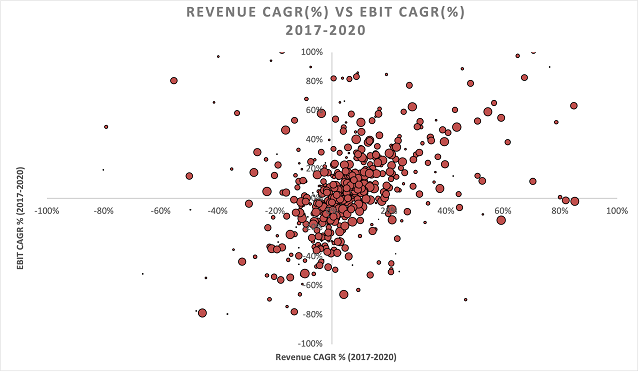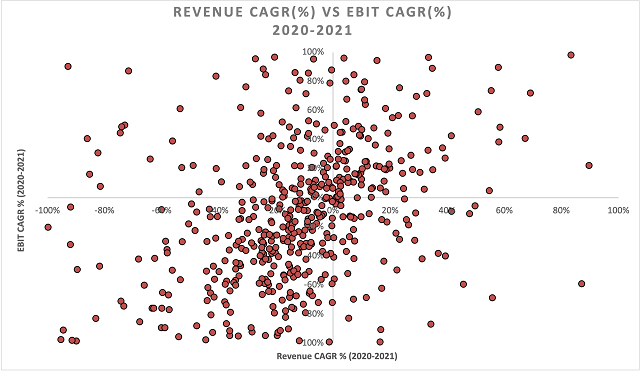The shape of the pyramid of Indian SMEs is bound to change by 2024 as we expect a wave of consolidation sweeping 10-20% of the lagging SMEs to extinction in the next 3-5 years.
Por Samir Sathe
The problems seem never-ending for small and medium enterprises (SMEs) in India post the second wave of COVID-19. To understand what separates the winners from the others and what to expect in the future we studied 732 listed SMEs, representative of the population of small and medium businesses, whose revenues are between $1 million and $30 million, during 2017 and 2021. We know that SMEs suffered during COVID-19, mainly in the financial year 2020-21. The severity is, however, telling while the difference between the winners and those left behind remains unexplained.
Pre COVID-19


Most of the SMEs recorded a revenue CAGR between -40% and +8%, EBIT CAGR between -30% and +6%, indicating that the firms were hammered on both margins and resultant cash flow crunch was experienced the most in the second and third quarters of 2020-21.
Our experience of working with SMEs indicates that the winners (the ones that showed resilience during the trauma of COVID-19 and are in a position now to capitalize on the next growth cycle) are characterized by five key positive attributes:
- being hungry for growth even in crisis
- being prepared to develop management capabilities
- embracing technology in transactions, relationships, and interactions
- protecting key customer accounts
- retaining key employees
SMEs having diversified product lines with focused customer segments fared better than the focused ones in general. However, the focused ones that exercised the five positive attributes fared better than diversified ones, in general.
Mid-sized firms >$10 million revenue weathered the COVID-19 storm better than those with revenues <$10 million in terms of revenue growth or margin protection.
Those who lost showed attributes of derailment in addition to not being able to demonstrate the five positive attributes stated earlier. They showed tendencies to borrow more as their cash needs skyrocketed, trapping them in debt cycles, inability to sweat their investments for new products and finally being unable to get leverage from their managers.
What could we expect in future?
The shape of the pyramid of Indian SMEs is bound to change by 2024 as we expect a wave of consolidation sweeping 10-20% of the lagging SMEs to extinction in the next 3-5 years. While quiet closures are imminent and immediate, distress sale procedures and value extraction plans may take more time and effort than commensurate returns. M&A firms will need to watch the action as the flurry of activity is set to swarm their corridors. The question is if there would be enough buyers as compared to those who need to sell.
We expect new firms to be born faster in the next three years than 10 in the past. It will be partly offset by the deaths of the SMEs, especially in the micro-enterprise segment. The population of home-based self-employed businesspersons is expected to grow fast.
India carries a potential of 3% of the 275,000 GSTN registered medium enterprises (revenues between $1 million and $30 million to cross the $ 30 million revenue threshold and be the large ones, and 15% of the 450,000 GSTN registered small enterprises of $1-3 million revenue to be the medium enterprises (revenues of $3-30 million) in the next 3-5 years. The pyramids may not look dramatically different, but in absolute numbers, the numbers still look big. These winners could be the first wave of global competitiveness. They would also have a catalytic impact on the rest of the SME community.
The investment in infrastructure, construction led products, and its derived sectors, the growth in B2B business services, consumption of entertainment, retail, healthcare goods and services, media, tertiary food processing zones, apparel, EVs, renewables, electronics, automotive services and EV, analytics, data sciences and technology-led sectors will witness a massive uplift by 2030. What is unclear is whether the benefit will be even across the SMEs in different revenue segments.
Those struggling to survive merit attention but not favours, capital but not subsidy. They need market access, not quotas. They need the capability, not just intent to grow. Finally, they need support and active investment from the winners, not just grants and CSR money. Finally, it’s time that the strong lifted the weak, not the weak dragging the strong down.
Fuente: Economic Times




